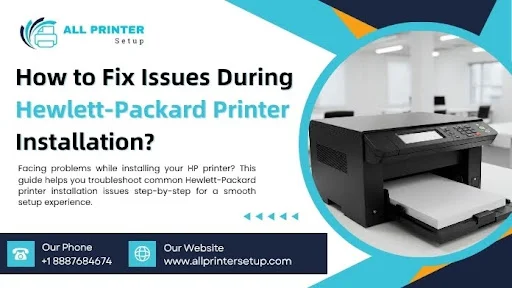Installing a Hewlett-Packard (HP) printer should be a straightforward process, but occasionally unforeseen issues get in the way. Whether you are using a Windows desktop, Mac, or mobile device, installation issues are inevitable. In this blog we will take you through the most typical HP printer installation issues and offer actionable solutions to fix them.
From connectivity issues to driver errors, we’ll discuss everything you need to know to get your printer up and running again. Whether you’re a home user or setting up a printer for your business, this guide will help you fix Hewlett-Packard printer installation problems with confidence.
Why Printer Installation Issues Happen
Printer installation issues can arise due to many factors. These could be due to old drivers, absence of system updates, incompatibility of printer software, or plain human error done during setup. Occasionally, security software or network settings may even prevent the setup process from taking place altogether. Understanding why these problems occur is the key to resolving them efficiently. Knowing these general causes enables you to take preventive measures and makes it easier to troubleshoot quickly.
1. Check the Basics First
Before diving into more complex troubleshooting steps, make sure the basic setup is complete:
- Is the printer powered on?
- Are all cables properly connected?
- Is there paper in the tray, and is the ink/toner installed?
- Is the printer display showing any error messages?
Surprisingly, many installation issues stem from these initial details being overlooked. A quick double-check can save a lot of time.
Knowledge is just a click away—come explore more with us online.
2. Use the Right Installation Software
To begin the Hewlett-Packard printer installation correctly, always use the latest drivers and setup tools provided by HP:
- Visit HP’s official support website.
- Search for your specific printer model (e.g., HP DeskJet 3755, HP LaserJet Pro M404n).
- Download the latest Full Feature Software and Driver for your operating system.
Avoid using generic drivers or third-party tools, as they may cause compatibility issues or limited functionality.
3. Ensure Compatibility With Your Operating System
If your printer installation fails, the problem might lie in system compatibility:
- Ensure your Windows or macOS version is compatible with the printer driver.
- On macOS, older printers may require additional permissions or firmware updates to function properly.
- For Windows 11 or 10, ensure your system is up to date with the latest patches and updates.
If you’re not sure whether your HP printer is compatible with your current OS, check the specifications listed on the HP support site.
4. Fix Network or USB Connection Issues
A standard Hewlett-Packard printer installation error involves the connection between your printer and computer:
For USB Printers:
- Try plugging the USB into a different port.
- Avoid using USB hubs or extension cables.
- Restart both the printer and computer before retrying.
For Wireless Printers:
- Ensure that both your printer and computer are connected to the same Wi-Fi network.
- Use the printer’s control panel to reconnect to Wi-Fi.
- Try the WPS button on your router and printer if available.
- Temporarily turn off VPNs or firewalls that may be blocking communication.
5. Run HP’s Diagnostic Tools
HP offers free tools designed to help resolve installation issues. These include:
- HP Smart App – Great for setup, scanning, and monitoring printer status.
- HP Print and Scan Doctor (for Windows) – Automatically detects and resolves printing and scanning issues.
- HP Easy Start – A guided installation tool that helps install drivers and connect printers.
If you’re unsure where to begin, these tools from HP simplify the troubleshooting process. Many users report that using these tools completes the installation of their Hewlett-Packard printer.
6. Clear Out Old or Failed Printer Installations
Sometimes, failed or duplicate installations can conflict with new ones:
- Go to Control Panel > Devices and Printers (Windows) or System Preferences > Printers & Scanners (Mac).
- Remove any duplicate or offline HP printers.
- Restart your system before attempting a new installation.
On Windows, also check Device Manager for any hidden printer entries under “Print Queues” and uninstall them.
7. Temporarily Disable Security Software
Firewalls, antivirus programs, or other security software can sometimes interfere with Hp printer installation:
- Temporarily turn off real-time protection.
- Disable VPNs and proxy connections.
- Ensure that your security settings do not block HP software from running.
Once installation is successful, you can re-enable your protection settings.
8. Update Printer Firmware
Firmware updates can fix bugs that affect connectivity or driver compatibility:
- Visit HP’s support site.
- Enter your printer model and locate firmware updates.
- Download and follow the instructions carefully.
Ensure that you do not turn off your printer during a firmware update, as this may cause permanent damage.
9. Install via Manual IP (For Network Printers)
If automatic detection fails during network setup, try manually installing your printer:
- Find your printer’s IP address from its control panel (usually under Network Settings).
- On Windows, go to Control Panel > Devices and Printers > Add a Printer > “The printer that I want isn’t listed.”
- Select “Add a printer using TCP/IP address” and enter the IP.
This is a great workaround when network discovery doesn’t function properly.
10. When All Else Fails: Reinstall everything
If nothing works, doing a clean reinstall may be the answer:
- Uninstall all HP-related drivers and software from your system.
- Restart your computer.
- Download fresh drivers from the HP support page.
- Run HP Easy Start or use the HP Smart App.
This clean slate often fixes complex conflicts that are otherwise hard to diagnose.
Final Thoughts
Troubleshooting Hewlett-Packard printer installation doesn’t have to be overwhelming. Most issues can be resolved with careful troubleshooting steps—such as checking cables, updating software, or using official HP tools. The key is not to rush the process. Work through the basics first, and only then move to advanced troubleshooting.
Remember, tools like HP Smart App, HP Easy Start, and HP Print and Scan Doctor are there to make your life easier. Don’t hesitate to use them. In many cases, they do the heavy lifting for you.
Want more insights like this? Head over to Management Works Media and start exploring.






